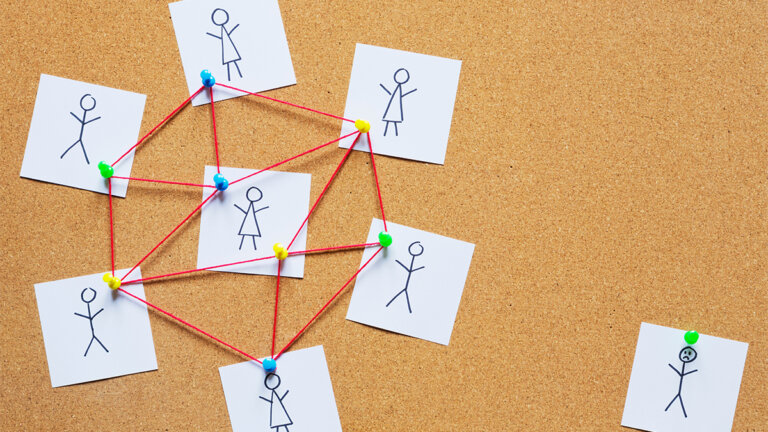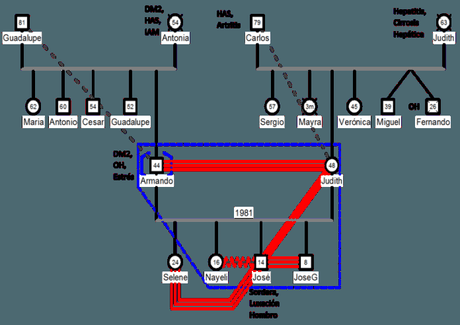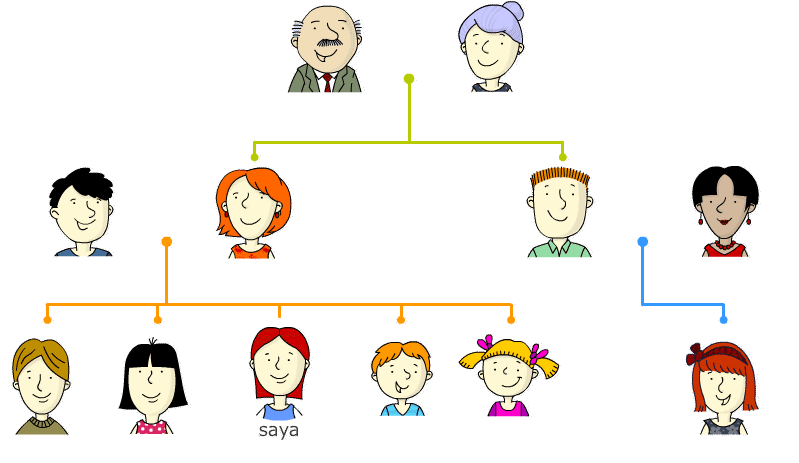A Step-by-Step Guide to Making a Genogram

A genogram is a tool that helps outline and summarize a person’s family information. It’s similar to a family tree. But it includes more specific aspects of the family connections and has a more more technical look.
The University of Barcelona’s psychology department defines genogram as, a graphic representation (in the form of a family tree) of the basic information of at least three generations of a family. It includes information on the family structure, the demographic data of the members, and their relationships.
“If you don’t know history, then you don’t know anything. You are a leaf that doesn’t know it is part of a tree.”
-Michael Crichton-
We use it to gather and organize information about a person’s immediate environment. This information is useful when it comes to a medical treatment and education.
But anyone can make their own genogram to get to know themselves better. It’s particularly useful for finding patterns: genetic issues, inter- or intragenerational problems, and environment-based behavioral patterns.
A genogram helps you quickly visualize the way your family structure looks. In many cases, it helps you come to a theory about the root causes of certain problems. It could be about personality, emotional management, etc. They’re also valuable tools for increasing your self-knowledge.
Steps of making a genogram
You make a genogram in three basic steps:
- General outline of family structure
- Recollection of basic information about a person’s family
- Description of family relationships.

The outline of the family structure is the first and most important phase. Here you’ll establish the biological and legal links between different members of the family. There is a group of set symbols to indicate these links.
Then you’ll add the following data into the family information section:
- Demographic information (dates of birth and death, education level, wedding and divorce dates, etc).
- Information on the level of functionality (general data about the functionality of the members: are they functional, to what degree, and why?).
- Crucial family events.
In the third stage you describe the details of the family relationships. Here you once again establish the links between members. But in this case you don’t worry about the biological or legal connections. You focus on the psychological links instead.
Making a genogram, step-by-step
To make a genogram from start to finish, you follow these steps:
 Determine the purpose for the genogram
Determine the purpose for the genogram
The first thing to do is determine what the purpose of the genogram will be. Of course, they all have to do with information about a person’s family history and family environment. But you can use that information in many different ways.
Sometimes the data you get is extremely useful for doctors. Family history is also genetic history and helps you visualize inherited physical strengths and weaknesses.
Genograms also include valuable information about recurring or common emotional problems in a family. They may be psychological patterns picked up and spread through the family environment.
There are also times when a genogram has one specific purpose. It’s perfect if you’re asking yourself: where does my depression come from? You can trace a particular condition down through the different generations. In any case, the important thing is to determine the purpose before you start.
Decide on the number of generations you’ll analyze
It’s important to give yourself a realistic goal. Ideally you’ll start with three generations, but that’s not always possible. There are families where an entire generation has disappeared, or they don’t have contact with some members.
There are other cases where contact with other generations is done indirectly. In other words, you can only get information about a family member through what other people say about them. This might result in a bias. Here, it’s best to find other sources of information to verify the accuracy of what they say.
It’s best to make a list of living members that you can get in touch with. Then make a new list of people who can give you information about family members you can’t get in touch with. And lastly, decide how many generations your genogram will include.
Make a questionnaire to gather information
This is one of the most important steps and it depends on the purpose you decided on. What it means is coming up questions to gather the information you need for your genogram.

It should consist of a series of basic questions eliciting demographic data. They should include things like: names, dates (birth, death, marriage, divorce, moving cities, etc). It should also include other things like social status, level of education, profession, number of children, sex of children, etc.
Then there should be a group of questions that will help you go deeper into the specific details about each family member. For example, illnesses they have or had, pain they’ve had to deal with, hobbies and interests, important experiences, major conflicts, etc.
Lastly, make a third group of questions to dig into crucial family incidents. These are moments of crisis or serious problems that several family members had in common. They marked a before and after in these family members’ lives. You can decide which crucial incidents you want to shed light on by remembering your genogram’s purpose.
Do research in the field
Not all genograms go as deep as others. Some focus on obvious aspects while others go deeper into one or many aspects. This will mostly depend on the direct information you’re able to get.
What this step is about is getting into contact with possible sources of information. It’s important to keep in mind that not everyone wants to talk about their personal story. That’s why, to begin with, you have to understand that it might be hard work that will take patience.
The best thing to do once you’ve contacted them is to immediately explain what you’re trying to get out of it. In this case, information to make a genogram. For everything to flow nicely, it’s best to do this over time. This way you can build trust and they’ll more readily give you information.
Gather document-based information
Letters, photos, videos, and any other family-related documents will eventually be very helpful. You may find an important piece of information in an ID card, a contract, or a medical prescription.
A lot of families have a treasured family album. That’s generally where you can find images of big group events. You can figure out a lot about a person when you look carefully at a photo. What emotional “climate” can you see in the photo? What attitude do they have towards each other?
Use standardized symbols
Nowadays there are templates for making genograms. They’re pre-made designs that have everything you’ll need to organize the information you gather. There are also computer programs that make it easier.

There are also standardized symbols to represent the data. Still, anyone can design their own symbols, if they feel like the standard ones don’t look good or work well. Regardless, these are the most commonly used symbols:
- Men are represented by a square, and women by a circle.
- Marriages are represented with the man’s symbol to the left and the woman’s symbol to the right, joined together by a horizontal line.
- Two diagonal, parallel lines represent a divorce or separation.
- The children are organized from oldest to youngest, going from left to right.
Never lose sight of your genogram’s purpose. So if you have to, create specific symbols to represent relevant things. They may be abuse, alcoholism, abortions, suicides, fatal accidents, or any other factor you’re following.
Make the framework with the links as your basis
What kind of relationships there are between family members is always an important piece of information. That’s why you don’t just show the link, you also add some kind of element indicating its quality. Even if it’s just in general terms.
Creating standardized symbols to represent relationships that are close, distant, tense, conflicted should be enough. And it’s also good to have some symbols to represent cases of physical, emotional, or sexual abuse. In a lot of cases you’ll have to add some element to indicate that it’s only a suspicion without evidence.
Analyze the genogram
Analyzing a genogram is a creative and often fascinating thing to do. It starts out as an evaluation of how accurate everything is in your visualization. If you have any doubts about any piece of information, it’s best to indicate so, or find out if it’s true.
This first analysis will help you organize the information as clearly and precisely as you can. This effort in precision will pay off when it comes to the next step.
Look for patterns
Now you’ll determine if the genogram is valid. All the information you’ve gathered, organized, and represented visually should help you find patterns. In other words, at this point you should be able to see any recurring events, circumstances, or elements.

The patterns are the key to understanding it all. Is there an illness that recurs in different family members and/or consecutive generations? Is there any pattern of dysfunctional behavior passed from generation to generation? Why do some members of the family not fit the pattern? What part of their personal history helped them break it?
These and many other questions should have an answer once you’ve finished a genogram. It definitely won’t have all the information possible, but it will give valuable clues. Most of all, it will help you understand the causes of something happening now.
See if it met its purpose
Making a genogram isn’t a mechanical activity, and it doesn’t give absolute results. The process might make you rethink the initial purpose a few times. Finding some unexpected piece of information can sometimes make you change your focus.
That’s why seeing if you’ve fulfilled your initial objective is useful. Figure out is if the information you found, organized, and interpreted enhances your understanding of the person. Often, even though a genogram didn’t completely fulfill its purpose, the process did help. So it’s worth doing a final evaluation of the process.

A genogram is essentially a picture of the road leading to your own story. It’s history written before you were born. After all, every one of us is just a chapter in a story that started a long time ago. All we can hear is the faint buzz of time, and all we get to see is a little, interesting glimpse.
Bibliography
McGoldrick, M. and Gerson, R. (1985) Genograms: Assessment and Intervention. New York, Norton.
A genogram is a tool that helps outline and summarize a person’s family information. It’s similar to a family tree. But it includes more specific aspects of the family connections and has a more more technical look.
The University of Barcelona’s psychology department defines genogram as, a graphic representation (in the form of a family tree) of the basic information of at least three generations of a family. It includes information on the family structure, the demographic data of the members, and their relationships.
“If you don’t know history, then you don’t know anything. You are a leaf that doesn’t know it is part of a tree.”
-Michael Crichton-
We use it to gather and organize information about a person’s immediate environment. This information is useful when it comes to a medical treatment and education.
But anyone can make their own genogram to get to know themselves better. It’s particularly useful for finding patterns: genetic issues, inter- or intragenerational problems, and environment-based behavioral patterns.
A genogram helps you quickly visualize the way your family structure looks. In many cases, it helps you come to a theory about the root causes of certain problems. It could be about personality, emotional management, etc. They’re also valuable tools for increasing your self-knowledge.
Steps of making a genogram
You make a genogram in three basic steps:
- General outline of family structure
- Recollection of basic information about a person’s family
- Description of family relationships.

The outline of the family structure is the first and most important phase. Here you’ll establish the biological and legal links between different members of the family. There is a group of set symbols to indicate these links.
Then you’ll add the following data into the family information section:
- Demographic information (dates of birth and death, education level, wedding and divorce dates, etc).
- Information on the level of functionality (general data about the functionality of the members: are they functional, to what degree, and why?).
- Crucial family events.
In the third stage you describe the details of the family relationships. Here you once again establish the links between members. But in this case you don’t worry about the biological or legal connections. You focus on the psychological links instead.
Making a genogram, step-by-step
To make a genogram from start to finish, you follow these steps:
 Determine the purpose for the genogram
Determine the purpose for the genogram
The first thing to do is determine what the purpose of the genogram will be. Of course, they all have to do with information about a person’s family history and family environment. But you can use that information in many different ways.
Sometimes the data you get is extremely useful for doctors. Family history is also genetic history and helps you visualize inherited physical strengths and weaknesses.
Genograms also include valuable information about recurring or common emotional problems in a family. They may be psychological patterns picked up and spread through the family environment.
There are also times when a genogram has one specific purpose. It’s perfect if you’re asking yourself: where does my depression come from? You can trace a particular condition down through the different generations. In any case, the important thing is to determine the purpose before you start.
Decide on the number of generations you’ll analyze
It’s important to give yourself a realistic goal. Ideally you’ll start with three generations, but that’s not always possible. There are families where an entire generation has disappeared, or they don’t have contact with some members.
There are other cases where contact with other generations is done indirectly. In other words, you can only get information about a family member through what other people say about them. This might result in a bias. Here, it’s best to find other sources of information to verify the accuracy of what they say.
It’s best to make a list of living members that you can get in touch with. Then make a new list of people who can give you information about family members you can’t get in touch with. And lastly, decide how many generations your genogram will include.
Make a questionnaire to gather information
This is one of the most important steps and it depends on the purpose you decided on. What it means is coming up questions to gather the information you need for your genogram.

It should consist of a series of basic questions eliciting demographic data. They should include things like: names, dates (birth, death, marriage, divorce, moving cities, etc). It should also include other things like social status, level of education, profession, number of children, sex of children, etc.
Then there should be a group of questions that will help you go deeper into the specific details about each family member. For example, illnesses they have or had, pain they’ve had to deal with, hobbies and interests, important experiences, major conflicts, etc.
Lastly, make a third group of questions to dig into crucial family incidents. These are moments of crisis or serious problems that several family members had in common. They marked a before and after in these family members’ lives. You can decide which crucial incidents you want to shed light on by remembering your genogram’s purpose.
Do research in the field
Not all genograms go as deep as others. Some focus on obvious aspects while others go deeper into one or many aspects. This will mostly depend on the direct information you’re able to get.
What this step is about is getting into contact with possible sources of information. It’s important to keep in mind that not everyone wants to talk about their personal story. That’s why, to begin with, you have to understand that it might be hard work that will take patience.
The best thing to do once you’ve contacted them is to immediately explain what you’re trying to get out of it. In this case, information to make a genogram. For everything to flow nicely, it’s best to do this over time. This way you can build trust and they’ll more readily give you information.
Gather document-based information
Letters, photos, videos, and any other family-related documents will eventually be very helpful. You may find an important piece of information in an ID card, a contract, or a medical prescription.
A lot of families have a treasured family album. That’s generally where you can find images of big group events. You can figure out a lot about a person when you look carefully at a photo. What emotional “climate” can you see in the photo? What attitude do they have towards each other?
Use standardized symbols
Nowadays there are templates for making genograms. They’re pre-made designs that have everything you’ll need to organize the information you gather. There are also computer programs that make it easier.

There are also standardized symbols to represent the data. Still, anyone can design their own symbols, if they feel like the standard ones don’t look good or work well. Regardless, these are the most commonly used symbols:
- Men are represented by a square, and women by a circle.
- Marriages are represented with the man’s symbol to the left and the woman’s symbol to the right, joined together by a horizontal line.
- Two diagonal, parallel lines represent a divorce or separation.
- The children are organized from oldest to youngest, going from left to right.
Never lose sight of your genogram’s purpose. So if you have to, create specific symbols to represent relevant things. They may be abuse, alcoholism, abortions, suicides, fatal accidents, or any other factor you’re following.
Make the framework with the links as your basis
What kind of relationships there are between family members is always an important piece of information. That’s why you don’t just show the link, you also add some kind of element indicating its quality. Even if it’s just in general terms.
Creating standardized symbols to represent relationships that are close, distant, tense, conflicted should be enough. And it’s also good to have some symbols to represent cases of physical, emotional, or sexual abuse. In a lot of cases you’ll have to add some element to indicate that it’s only a suspicion without evidence.
Analyze the genogram
Analyzing a genogram is a creative and often fascinating thing to do. It starts out as an evaluation of how accurate everything is in your visualization. If you have any doubts about any piece of information, it’s best to indicate so, or find out if it’s true.
This first analysis will help you organize the information as clearly and precisely as you can. This effort in precision will pay off when it comes to the next step.
Look for patterns
Now you’ll determine if the genogram is valid. All the information you’ve gathered, organized, and represented visually should help you find patterns. In other words, at this point you should be able to see any recurring events, circumstances, or elements.

The patterns are the key to understanding it all. Is there an illness that recurs in different family members and/or consecutive generations? Is there any pattern of dysfunctional behavior passed from generation to generation? Why do some members of the family not fit the pattern? What part of their personal history helped them break it?
These and many other questions should have an answer once you’ve finished a genogram. It definitely won’t have all the information possible, but it will give valuable clues. Most of all, it will help you understand the causes of something happening now.
See if it met its purpose
Making a genogram isn’t a mechanical activity, and it doesn’t give absolute results. The process might make you rethink the initial purpose a few times. Finding some unexpected piece of information can sometimes make you change your focus.
That’s why seeing if you’ve fulfilled your initial objective is useful. Figure out is if the information you found, organized, and interpreted enhances your understanding of the person. Often, even though a genogram didn’t completely fulfill its purpose, the process did help. So it’s worth doing a final evaluation of the process.

A genogram is essentially a picture of the road leading to your own story. It’s history written before you were born. After all, every one of us is just a chapter in a story that started a long time ago. All we can hear is the faint buzz of time, and all we get to see is a little, interesting glimpse.
Bibliography
McGoldrick, M. and Gerson, R. (1985) Genograms: Assessment and Intervention. New York, Norton.
All cited sources were thoroughly reviewed by our team to ensure their quality, reliability, currency, and validity. The bibliography of this article was considered reliable and of academic or scientific accuracy.
- Ceberio, M. (2004) “Quién soy y de dónde vengo: El taller de genograma” Ed. Tres Haches.
- McGoldrick, M. y Gerson, R. (1985) Genogramas en la evaluación familiar. Barcelona: Gedisa (3ª ed. 2000).
This text is provided for informational purposes only and does not replace consultation with a professional. If in doubt, consult your specialist.







